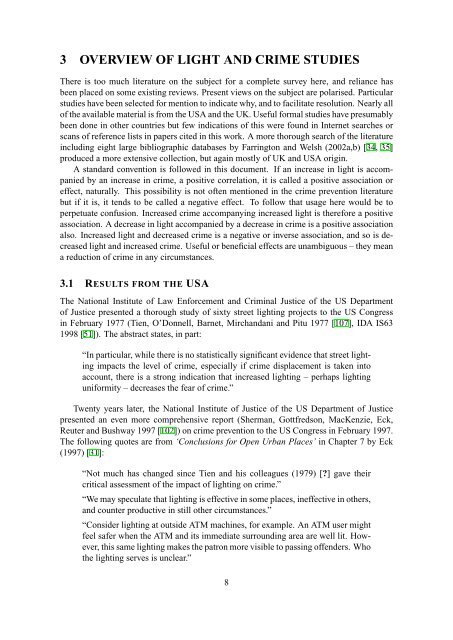outdoor lighting and crime, part 1 - Astronomical Society of Victoria
outdoor lighting and crime, part 1 - Astronomical Society of Victoria
outdoor lighting and crime, part 1 - Astronomical Society of Victoria
You also want an ePaper? Increase the reach of your titles
YUMPU automatically turns print PDFs into web optimized ePapers that Google loves.
3 OVERVIEW OF LIGHT AND CRIME STUDIES<br />
There is too much literature on the subject for a complete survey here, <strong>and</strong> reliance has<br />
been placed on some existing reviews. Present views on the subject are polarised. Particular<br />
studies have been selected for mention to indicate why, <strong>and</strong> to facilitate resolution. Nearly all<br />
<strong>of</strong> the available material is from the USA <strong>and</strong> the UK. Useful formal studies have presumably<br />
been done in other countries but few indications <strong>of</strong> this were found in Internet searches or<br />
scans <strong>of</strong> reference lists in papers cited in this work. A more thorough search <strong>of</strong> the literature<br />
including eight large bibliographic databases by Farrington <strong>and</strong> Welsh (2002a,b) [34, 35]<br />
produced a more extensive collection, but again mostly <strong>of</strong> UK <strong>and</strong> USA origin.<br />
A st<strong>and</strong>ard convention is followed in this document. If an increase in light is accompanied<br />
by an increase in <strong>crime</strong>, a positive correlation, it is called a positive association or<br />
effect, naturally. This possibility is not <strong>of</strong>ten mentioned in the <strong>crime</strong> prevention literature<br />
but if it is, it tends to be called a negative effect. To follow that usage here would be to<br />
perpetuate confusion. Increased <strong>crime</strong> accompanying increased light is therefore a positive<br />
association. A decrease in light accompanied by a decrease in <strong>crime</strong> is a positive association<br />
also. Increased light <strong>and</strong> decreased <strong>crime</strong> is a negative or inverse association, <strong>and</strong> so is decreased<br />
light <strong>and</strong> increased <strong>crime</strong>. Useful or beneficial effects are unambiguous – they mean<br />
a reduction <strong>of</strong> <strong>crime</strong> in any circumstances.<br />
3.1 RESULTS FROM THE USA<br />
The National Institute <strong>of</strong> Law Enforcement <strong>and</strong> Criminal Justice <strong>of</strong> the US De<strong>part</strong>ment<br />
<strong>of</strong> Justice presented a thorough study <strong>of</strong> sixty street <strong>lighting</strong> projects to the US Congress<br />
in February 1977 (Tien, O’Donnell, Barnet, Mirch<strong>and</strong>ani <strong>and</strong> Pitu 1977 [107], IDA IS63<br />
1998 [51]). The abstract states, in <strong>part</strong>:<br />
“In <strong>part</strong>icular, while there is no statistically significant evidence that street <strong>lighting</strong><br />
impacts the level <strong>of</strong> <strong>crime</strong>, especially if <strong>crime</strong> displacement is taken into<br />
account, there is a strong indication that increased <strong>lighting</strong> – perhaps <strong>lighting</strong><br />
uniformity – decreases the fear <strong>of</strong> <strong>crime</strong>.”<br />
Twenty years later, the National Institute <strong>of</strong> Justice <strong>of</strong> the US De<strong>part</strong>ment <strong>of</strong> Justice<br />
presented an even more comprehensive report (Sherman, Gottfredson, MacKenzie, Eck,<br />
Reuter <strong>and</strong> Bushway 1997 [102]) on <strong>crime</strong> prevention to the US Congress in February 1997.<br />
The following quotes are from ‘Conclusions for Open Urban Places’ in Chapter 7 by Eck<br />
(1997) [31]:<br />
“Not much has changed since Tien <strong>and</strong> his colleagues (1979) [?] gave their<br />
critical assessment <strong>of</strong> the impact <strong>of</strong> <strong>lighting</strong> on <strong>crime</strong>.”<br />
“We may speculate that <strong>lighting</strong> is effective in some places, ineffective in others,<br />
<strong>and</strong> counter productive in still other circumstances.”<br />
“Consider <strong>lighting</strong> at outside ATM machines, for example. An ATM user might<br />
feel safer when the ATM <strong>and</strong> its immediate surrounding area are well lit. However,<br />
this same <strong>lighting</strong> makes the patron more visible to passing <strong>of</strong>fenders. Who<br />
the <strong>lighting</strong> serves is unclear.”<br />
8
















